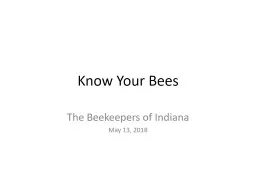

May 13 2018 Know Your Bees Wasp Family Paper Wasps Hornets Yellow Jackets Mud Daubers Mason Bees Carpenter Bees Bumble Bees Honey Bees Which One is the Honey Bee ID: 776117
Download Presentation The PPT/PDF document " Know Your Bees The Beekeepers of Indian..." is the property of its rightful owner. Permission is granted to download and print the materials on this web site for personal, non-commercial use only, and to display it on your personal computer provided you do not modify the materials and that you retain all copyright notices contained in the materials. By downloading content from our website, you accept the terms of this agreement.
Slide1
Know Your Bees
The Beekeepers of Indiana
May 13, 2018
Slide2Know Your Bees
Wasp Family
Paper Wasps
Hornets
Yellow Jackets
Mud Daubers
Mason Bees
Carpenter Bees
Bumble Bees
Honey Bees
Slide3Which One is the Honey Bee?
A
C
B
D
The Answer is: A
Honey Bee
Bumble Bee
Yellow Jacket
Hornet
Slide4Paper Wasps
Build Umbrella Like Nests Mostly Around Doors and in Boxes Less Aggressive Than Hornets and Yellow Jackets Sting Multiple Times Eliminate with Spray Sunset or very early in the morning Do not stand directly under the nest After 24 hours, knock down the nest Scrape and bleach the stem start ¾” Long Die During the Winter
Slide5Hornets
Build Tear Drop Shaped Enclosed Nests Single Opening Usually on Bottom Mostly on Limbs and Bushes Extremely Aggressive Sting Multiple Times Eliminate with Spray Treat Wearing Full Suit Sunset, Cover with bag After 24 hours, remove the nest 2” Long Die During the Winter
Slide6Yellow Jackets
Mostly Nest in the Ground Often Mistaken for Honey Bees Extremely Aggressive Sting Multiple Times Eliminate with Spray or Hot Water Late at Night Dig up nest and destroy ½” Long Die During the Winter
Slide7Mud Daubers
Nest on Side of Buildings Tube-like Cells Less Aggressive Rarely Sting Eliminate with Spray Smash the tubes Remove tubes ½” to 1” Long Die During the Winter
Slide8Mason Bees
In Wood, Twigs, Native to American Great Pollinators Do Not Make Honey or Beeswax Every Female Has Own Nest Males Emerge First Each Spring Elimination Not Required 1/4” to 3/8” Long Stay In Cocoon Until Spring Revisit Old Nests
Slide9Carpenter Bees
In Wood, Drill Near Perfect Round Hole Nest is Much Larger, Shiny Black Adomen Rarely Sting, Male Has No Stinger Size Is Scary Elimination Requires Treating the Nest Use a long residual dust Long nozzle sprayer 1” Long Hibernate During the Winter Revisit Old Nests
Slide10Bumble Bees
Usually on the Ground Under a Tarp or Deck Late Summer Queens Find Loose Bark Avoid Human Contact Less Aggressive Can Sting Multiple Times Elimination Clean up area, or Pest Control Professionals; Cypermethrin ¾” to 1 ½” Long Die During the Winter
Slide11Honey Bees
Inside Trees and Structure Wax Comb Less Aggressive Can Only Sting Once Aggravated by Vibration, Loud Noises, Smell Scrape the Stinger Call a Beekeeper ½” to ¾” Long Do Not Die During the Winter Hive May Have 10 to 50k
Slide12Does and Don’ts
Hit It With a Stick
Shoot It With a Gun
Wave Your Hands
Attempt to Eliminate Yourself
Do Not Use Lawn Mower Until Bees are Neutralized
Do Not Cut Down the Tree
Until Bees are
Neutralized
Honey Bee Stings
Pull
a
stinger out
with
your nails
Scrape the stinger out
Slide13If You Get Stung
Use a Cold Compress Where Stung
remove
the stinger first then apply a chopped white onion to the area. The anti-inflammatory properties of the onion will reduce the swelling and draw out the poison to speed up the healing process.
Take an Antihistamine
3
%
Have
an
Allergic Reaction
Redness
Painfull
Swelling
Itching
0.8
%
Life-threatening Allergic
Hives
Difficulty
breathing or
swallowing
Wheezing
or similar
symptoms
Slide14Additional Information
Mike and Debbie Seib
317-432-4352 Mike’s Cell
317-432-9578 Debbie’s Cell
mike@seibshoosierhoney.com
Kathleen
Prough
317-412-3315
Cell
kprough
@dnr.IN.gov